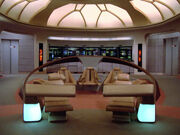
The bridge served as the central command and operations center of a starship
The bridge, also known as the main bridge or the command bridge, was the starship equivalent of an operations center or command center.
Starfleet bridge design[]
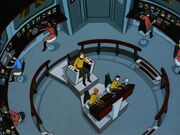
Overview of a 23rd century Starfleet bridge
On Starfleet ships, it was generally located near the top and front of a vessel. From here, the commanding officers supervised all ship's operations, ranging from vessel course control to tactical systems.
On Starfleet vessels, the bridge was usually located on Deck 1, on top of the vessel's primary hull. The bridge was the nerve center of every starship, and it was manned by the top officers of each department except for engineering and medical. There was typically an engineering station that the chief engineer could use when on the bridge, as well as science stations that the science officer or chief medical officer could use.
The commanding officer could supervise all the ship's operations while seated in the command chair, typically located in the center of the room, while having visual access to all major personnel stations and viewscreens, facilitating the decision-making process. By the mid-24th century, the standard was that a first officer was assigned to assist a ship's captain in this process.
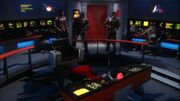
Main bridge of the Constitution-class USS Defiant
The forward bulkhead of the bridge was typically dominated by the main viewscreen. Directly in front of this was usually the helm console, from where navigation and vessel course control were carried out.
Many of the support stations that were present on 23rd century bridges were combined into one post by the 24th century, mainly that of the operations officer. Some bridges featured an operations console alongside the helm station, from where the officer on duty had access to internal systems control, communications, sensors, resource scheduling, and hardware and system usage.
Each bridge typically featured several supportive consoles for engineering, gravity control, damage control, environmental engineering, sciences, and library computer, most of which did not necessarily need to be manned under normal circumstances. Internal security along with weapons control could be found at the security station.
Features[]
Command stations[]
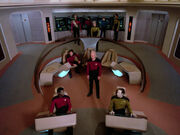
The bridge of a 24th-century Galaxy-class starship featuring three command chairs at center
The bridge command stations provided seating and information displays for the commanding officer and one or two other officers, typically including the first officer. The command chairs were located in the center of the bridge, to maximize interaction with all key bridge personnel, while permitting an unobstructed view of the main viewscreen.
Typically, the armrests of the captain's chair featured miniaturized status displays. Using a keyboard or vocal commands, the captain could use these controls to override the basic operation of the starship. (TOS: "Court Martial"; TNG: "Peak Performance", et al.)
In the scripts for Star Trek: The Next Generation, the location of the command stations was identified as the "command area". [1]
Flight control[]
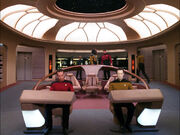
The ops and conn consoles on the Galaxy-class bridge (forward)
The 24th century flight control position, also referred to as the conn, evolved from the 23rd century helm and navigation positions. The officer manning the flight control console was responsible for the actual piloting and navigation of the starship. Despite many of these functions being heavily automated, their critical nature demanded a humanoid officer to oversee these operations at all times.
During spaceflight at impulse, the conn was responsible for monitoring relativistic effects as well the inertial damping system status. When traveling at warp speed, conn was required to monitor the subspace field geometry in parallel with the engineering department. During warp flight, the conn console continually updated long-range sensor data and made automatic course corrections to adjust for minor variations in the density of the interstellar medium. (Star Trek: The Next Generation Technical Manual, p. 35)
Operations management[]
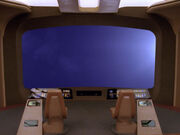
The ops and conn consoles on the Galaxy-class bridge (rear)
Many shipboard operations involved scheduling resources or hardware that affected a number of departments. In many such cases, it was common for various operations to present conflicting requirements. It was the responsibility of the operations officer to coordinate such activities so that mission goals were not jeopardized.
The operations position, also known simply as ops, evolved from older 23rd century positions. The bulk of the duties held by the helm and navigation positions were combined into the conn position. Other functions of the helm panel, such as internal systems control, became the purview of ops, as well as some communications and sensor system usages.
The ops panel presented the operations officer with a continually updated list of current major shipboard activities. This list permitted ops to set priorities and allocate resources among current operations. This was especially critical in cases where two or more requests required the use of the same equipment, entailed mutually exclusive mission profiles, or involved some unusual safety or tactical considerations.
During away team missions or emergency situations, the ops station was supported by the science station, found at the rear of the bridge in Galaxy-class designs. (Star Trek: The Next Generation Technical Manual, pp. 37-38, 40-41)
Security and tactical[]
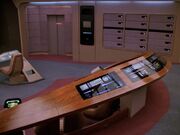
The security station, integrated in the wooden handrail encircling the Galaxy-class bridge
The bridge station dedicated to defensive systems control and starship internal security was tactical. Parts of the default control layout presented the security officer with information readouts dealing with the internal protection of the starship and its crew. A wide variety of starship defensive systems were available to the chief tactical officer (sometimes doubling as chief of security), ranging from the defensive shields to phaser and torpedo systems, as well as intrusion detection systems.
Other systems that could be commanded by tactical included communications, long- and short-range sensor arrays, sensor probes, message buoys, and tractor beam devices.
Supportive stations[]
Every Starfleet bridge also included several supportive consoles and backup stations. These could include consoles for planetary sciences, engineering, mission operations, and environmental control. Most of these were meant to relieve the senior bridge officers of secondary duties during alert and crisis situations.
Mission ops provided additional support to the operations officer, and was specifically responsible for monitoring activity relating to secondary missions. Mission ops was responsible for assignment of resources and priorities according to guidelines specified by the operations officer and by operating protocols. This station was also responsible for monitoring away teams. (Star Trek: The Next Generation Technical Manual, pp. 41-42)
The environmental control console provided similar relief to the operations officer, monitoring the starship's life support systems. Due to the highly automated nature of these systems, this console was unattended under normal circumstances, but became of crucial importance during alert situations to maximize crew survivability.
The bridge's engineering station duplicated in simplified form the chief engineer's primary status displays from main engineering. The purpose of this station was to permit the chief engineer to maintain supervision over the engineering system while on the bridge.
22nd century bridge design[]
Freedom class[]
NX class[]
Command area[]

The command area at the catwalk
When the crew of Enterprise NX-01 had to take shelter at the ship's catwalk in September 2152, Commander Tucker and Travis Mayweather built a "command area" within one of the compartments to replace the main bridge. Conn and the communications station included, the small area also included a provisional captain's chair, a cargo container with a netting, and place for Archer and T'Pol to sleep. (ENT: "The Catwalk")
23rd century bridge design[]
Most of the bridges during the later half of the 23rd century shared a similar layout to that of the upgraded Constitution-class vessels, which evidently set the standard for bridge design and layout.
Kelvin type[]
Kelvin-type bridges were large with many consoles and three windows acting as the viewscreen. They shared the joint helm/navigation consoles of Constitution-class starships. (Star Trek)
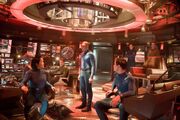
The Kelvin's bridge in a deleted scene
Walker class[]
Unusually for Starfleet vessels, Walker-class ships had their bridge placed at the bottom of the saucer section. Like the Kelvin-type bridge, it used a large window as the viewscreen.
Crossfield class[]
The Crossfield-class bridge was placed in a spherical section within the inner negative space of the saucer section. It possessed a wide window as the viewscreen, similar to Kelvin-type and Walker-class ships.
Constitution class[]
Huron type[]

Huron bridge
Huron-type bridge. (TAS: "The Pirates of Orion")
Oberth class[]
Miranda class[]
Excelsior class[]
24th century bridge design[]
In the early half of the 24th century, before the introduction of the Galaxy-class starship, bridge design was based on the successful layout of the Constitution-class starship, featuring a single captain's chair in the center of the room with two consoles directly in front of it and additional consoles surrounding this central command area.
The bridges of the Ambassador, Constellation, and Nebula-class starships were all redresses of the same set, first built, partially, for TNG: "The Battle". The same set eventually also ended up being used for the Olympic-class starship USS Pasteur, Beverly Crusher's ship in the anti-time future.
Galaxy class[]
Intrepid class[]
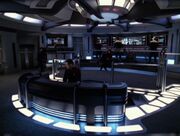
The Intrepid-class starship bridge
The Intrepid-class bridge was ovoid in shape. At the bridge's rear was a large bank of consoles and data-readout screens. Center of that area was the master systems display. Control consoles flanked it on either side, mission ops I to starboard and mission ops II to port.
Starboard of that information center, past the starboard side turbolift, was the chief tactical officer's console. This area was maintained mostly for internal security and combat situations. An identical station could be found on the other side of the bridge, where the operations console was found.
Two turbolifts provided access throughout the ship, and there was an emergency ladder which connected the bridge with lower decks. Forward of the upper ship operations areas were doorways to the briefing room at one side, and the captain's ready room at the other.
Directly forward of the central command area (where the captain and first officer were seated) and sunken down by two steps was the Conn. From here, the flight control officer served as helmsman and navigator for the vessel. To the Conn's right sat the chief engineer. The console allowed complete control over all engineering systems. Directly opposite sat the chief science officer in a similar console. (VOY: "Caretaker")
Behind the captain's chair, there was a small secondary tactical console located on the handrail. On the USS Voyager, this station was typically unmanned, however Seven of Nine used this station on several occasions, particularly on encounters with the Borg. Other crew members, such as The Doctor and B'Elanna Torres, used this station on occasion.
In between the captain's and first officer's chairs there was a small console which could be folded down when not in use, or opened and accessed by either officer. Like the larger consoles on the bridge a phaser could be stored within this unit.
Background information[]
After six years as production designer on The Next Generation, Richard James was no stranger to the legacy of Star Trek and the production requirements of episodic television. When given the assignment to create a new starship from the inside out, he had to start up from scratch.
Nothing had yet been established, and thus for his first meeting with Star Trek: Voyager's creators and producers, James decided to push the boundaries of everything that had gone before. Early concept sketches show bridge designs without the large viewscreen in the front of the bridge and command functions decentralized, obviously breaking the traditional bridge mold.
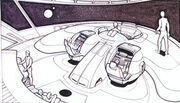
A Jim Martin concept art for the Voyager's bridge
However, by exhaustively reexamining the dramatic requirements and technological underpinnings of the Star Trek bridge without preconceptions, James rediscovered the strengths of the basic template laid out by Matt Jefferies almost thirty years earlier. But with the broad strokes of the bridge's layout firmly embedded in Star Trek's past, James and his team went on to bring a fresh new interpretation to the heart of every Star Trek adventure, investing it with a sleek, efficient, and welcoming appearance that made Voyager something of its own – the Star Trek for the nineties and beyond.
Sovereign class[]
The central area of the main bridge provided seating and information displays for the captain and two other officers. The captain's chair was raised from the rest of the bridge officers, to that of the surrounding level which included Tactical and Operations. The two officer seats were equipped with fully programmable consoles for a variety of uses.

The main bridge of the Sovereign-class starship
Directly fore of the command area was the conn officer, who faced the main viewer. To the port side of the conn officer, also facing the main viewer, was the operations officer's console, which was identical in size and design to the helm station. At the very front of the bridge chamber was a large viewscreen. In 2373, when the screen was not active, a standard bulkhead was present.
Aft and to the left of the command area was an elevated platform on which tactical and security consoles were located. To the captain's right, behind the tactical console, was the mission operations section of the bridge. Against the port side walls of the main bridge were the consoles for sciences along with others that were programmable for a multitude of functions.
Located against the aft wall of the bridge was a large master systems display monitor, similar to the one in main engineering. All relevant ship information (such as damage, power distribution, etc.) was displayed on the cutaway image of the vessel. This monitor could be used to direct ship operations and could be configured for limited flight control if necessary. Also located against the aft wall of the main bridge was the large engineering console. This had a smaller cutaway diagram of the vessel, which displayed all engineering-relevant data and showed warp fields and engine output.
There were two turbolifts on the bridge that could handle normal transit around the Sovereign-class starship. In addition, there was an emergency ladder that connected the bridge to lower decks. There was also one door, on the aft platform of the bridge, that led to the observation lounge, directly aft of the main bridge, with another door leading to the captain's ready room. (Star Trek: First Contact)
At least for Star Trek: First Contact, the Sovereign-class bridge was built on Paramount Stage 29.
Defiant class[]
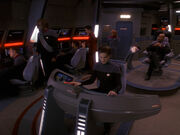
The Defiant-class' bridge at red alert
The bridge layout of the Defiant-class was compact, but nonetheless accommodated the familiar engineering, tactical, science, conn, and ops stations. The bridge module was sunken into a much larger deck 1 than on most Federation starships to provide added protection during combat situations. Access to the bridge was provided by two doorways at the back, located on both port and starboard sides. Just forward of the starboard entryway was the location of the ship's dedication plaque, as well as an auxiliary computer access panel.
The port side of the bridge housed the engineering and tactical I stations, while the starboard side featured the science and tactical II consoles. Because of its nearly exclusive role as a combat vessel, stations aboard Defiant-class vessels were designed with speed in mind.
The center of the bridge featured the lone captain's chair, which was on a raised platform and had a clear view of all bridge stations, as well as of the main viewscreen. On both sides of the command chair were separate control panels, allowing the occupant access to virtually every system aboard the ship. Between the command chair and the viewscreen was an integrated flight control and operations panel, capable of performing the joint duties of those stations' larger counterparts on other Starfleet vessels. Like all of the bridge stations on Defiant, the conn had been designed for maximum speed and efficiency of commands input by the operator, allowing the craft to be handled almost like a fighter when under the hands of a skilled pilot.
Flanking both sides of the viewscreen were two tactical stations, which had primary access to the ship's powerful pulse phaser cannons, torpedo launchers and various other special ordinance packages. Working closely with conn, the officers stationed at these consoles were responsible for firing the various weapons aboard the Defiant-class starship during combat operations. The purpose of the tactical II station was to lighten the load on its sister station, particularly in battle.
Prometheus class[]
Nova class[]
Luna class[]
Dauntless class[]
In 2384, the location of the main bridge for the USS Dauntless on Deck A was labeled on a master situation display. (PRO: "Mindwalk")
A clear view of the MSD was provided by Dominique Rossier of Wardenlight Studio. [2]
Non-Starfleet bridge design[]
Klingon vessels[]
K't'inga class[]
Bird-of-Prey[]
Vor'cha class[]
Romulan vessels[]
Bird-of-Prey[]
D'deridex class[]
Valdore type[]
Scimitar[]
- See: Scimitar main bridge
Narada type[]
The Narada's consoles were dotted around the ship due to the ship's spacious design. (Star Trek)
According to the Blu-ray's "Starfleet Vessel Simulator", each of the crew's consoles were altered to be separate from each another so they could privately mourn the destruction of Romulus.
Bridge designs of other species[]
Borg[]
The Borg possessed the only known vessels not to have a discrete bridge, but whose controls were instead highly decentralized, being run collectively by the Borg drones. (TNG: "Q Who") However, Borg ships did have a command center known as the central plexus.
Dominion[]
Jem'Hadar attack ships had a bridge that was very peculiar in that it had no chairs, and only two head-mounted Virtual sensory displays instead of a viewscreen. Only the Jem'Hadar First and leading Vorta were allowed to view the outside of the ship. (DS9: "A Time to Stand")
Son'a[]
Mirror universe bridge design[]
NX class[]

Bridge of the NX-class ISS Enterprise (2155)
The bridge of the Terran Empire's NX-class ISS Enterprise was quite similar in appearance to that of its counterpart from the prime universe, only that it featured Terran Empire emblems painted on the walls. (ENT: "In a Mirror, Darkly") The bridge of Admiral Black's flagship, the ISS Avenger, was similar in appearance to that of the Enterprise. (ENT: "In a Mirror, Darkly, Part II")
Constitution class[]

Bridge of the Constitution-class ISS Enterprise (2267)
Similarly, the only differences between the bridge of the 23rd century ISS Enterprise from the mirror universe and its counterpart from the prime universe was the appearance of Terran Empire emblems appearing on walls and doors, and a high-backed throne-like command chair. Also, guards were stationed on the bridge under all circumstances. (TOS: "Mirror, Mirror")
Defiant class[]
The bridge of the Terran Rebellion's ISS Defiant was similar to that of the Defiant-class bridge from the prime universe, the vessel's schematics being based on specifications stolen from Starfleet at Deep Space 9. (DS9: "Shattered Mirror")
Alternate reality[]
Constitution class[]

The alternate Enterprise bridge

Forward view
The alternate reality's Constitution-class bridge retained the largeness of the Kelvin-type bridges, as well as the use of the viewscreen as a window. It was larger than the prime or mirror universe's bridge, featuring more consoles in addition to the command chair, science station, communications station, helm, and navigation consoles, which were roughly in the same place. It was aesthetically much brighter and smoother, with white paint, blue monitor screens, more lights (that would bathe the room red when red alert was signaled), and even transparent touchscreen boards. A turbolift was located on the port side, while airlock doors were on the starboard side. (Star Trek)
Production designer Scott Chambliss explained on the Blu-ray that the bridge was inspired by Pierre Cardin's architecture.
Appendices[]
See also[]
Further reading[]
- Star Trek: The Next Generation Technical Manual, Michael Okuda and Rick Sternbach, Pocket Books, 1991.
- The Art of Star Trek, Judith and Garfield Reeves-Stevens, Pocket Books, 1997.
Background information[]
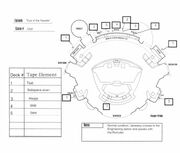
A diagram of an Intrepid-class bridge, showing what each monitor would display during a particular scene
- "Family" was the only episode of Star Trek: The Next Generation in which no scene was set on the bridge of the Enterprise-D. Previously, "The Slaver Weapon" was the only episode between Star Trek: The Original Series and Star Trek: The Animated Series in which no scene featured the bridge of the original Enterprise.
- The concept of replaceable bridge modules on Starfleet vessels allowed for the usage of different bridge layouts for the same starship class, and so explains why the bridge of the USS Enterprise-A was different in all movies it appeared in and why both the Miranda- and Galaxy-class starships were seen with different types of bridges. (citation needed • edit)
- The precarious location of the bridge was finally addressed in ENT: "Twilight", when the Xindi shot off the Enterprise NX-01's bridge, killing the entire bridge crew (in an alternate reality), as well in Star Trek Nemesis in which the Scimitar fired at the Enterprise's bridge and destroyed the frontal area, exposing it to space and killing at least one crewmember.
External links[]
- Bridge at Memory Beta, the wiki for licensed Star Trek works
- Bridge (nautical) at Wikipedia
- Bridge Gallery at Ex Astris Scientia
- Interview with designer Andrew Probert at Forgotten Trek
- Interview with Matt Jefferies(X) at BBC Online

